Paving slabs in the country: varieties of shapes and materials

Paving slabs in the country are a kind of indicator of the owner's taste. It would seem that such an unprepossessing detail is a tiled path. Meanwhile, such paths look exquisite, delicately playing up the landscape and the design of the area.
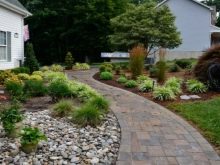
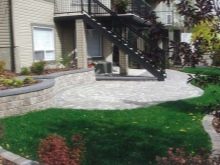
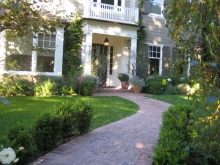
Features: advantages and disadvantages
For most of us, when pronouncing the phrase "paving slabs", an image of paths in parks and city squares arises. The tile has long chosen a place for itself there. Wear-resistant, not afraid of frost or excess moisture, puddles do not linger on it, and outwardly it is attractive, fits into any landscape.
Such a paved surface will last for several decades. (from 15 to 20 years old). It is easy to install and repair. Just a great material to lay out both an unpretentious path for walking and a spacious paved area.
Today there is a huge selection of the most diverse paving slabs. One way or another, all of them will perfectly cope with their task - to be a reliable covering for the road. Only when laying products is one aspect worth considering - the load on this coating. Will it be used by vehicles or will only be used for evening promenades?
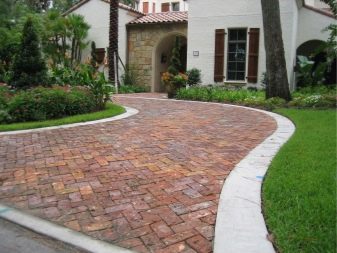
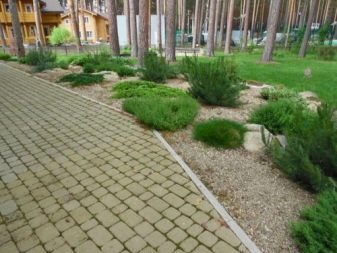
In the first case, you will need a tile thicker than 4-6 cm, and besides, you will need to additionally strengthen the base.
If the transport permeability of the future paved area is very high, then it is even possible to use paving stones instead of tiles. If only people and animals walk along the path, then the required thickness of the products will be much less.
Paving slabs have one unpleasant feature. When installing it, you must have a stock of material. On average, about 5% of the total planned volume. If there is an excess, then it may be needed in the future for piece repairs.
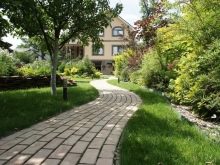
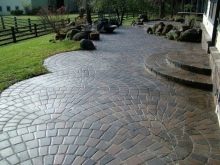
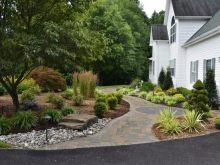
Views
There are an enormous mass of varieties of paving slabs. It can differ in design, be of a certain shape, have a different size and thickness, and, of course, be different in the method of manufacture and the materials used for its production.
If we take into account the materials from which the tile is made, then it can be:
- concrete;
- from natural stone, its cuts;
- with crumb rubber;
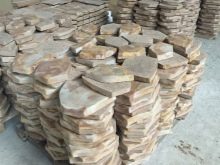
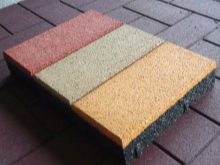
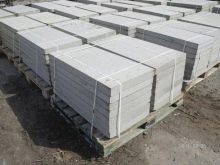
- clinker, made of special clay;
- polymer sand or plastic;
- and also luminous (with built-in LEDs).
In turn, concrete products can differ in their characteristics, since they are made in two different ways: vibrocasting or vibrocompression.
The right coating allows you to achieve a variety of design goals.
So, for example, you can get as close to nature as possible with the help of eco-style tiles. It is intended for laying the covering where greenery will grow in the future. The grass will punch through the holes in the tiles.
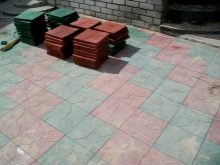
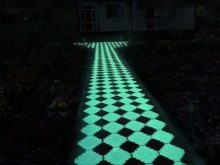
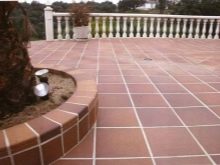
Shapes and design
In terms of the choice of textures, colors, shapes and design, paving slabs have a wide range of models in their arsenal. It can take the simplest and most typical shapes for a slab (square, rectangle), or it can be hexagonal, round, scaly and other original silhouette. In addition, paving slabs can imitate various textures of natural stone and wood.
Varieties of popular paving slabs by design:
- Paving stones are not exactly paving slabs, rather, their "progenitor", but a very popular material for laying paths. It is distinguished by an exceptionally rectangular shape, a large thickness of products (the tiles are much thinner), and a characteristic color.
- Classic - most often square, simple, without patterns, with many color options.

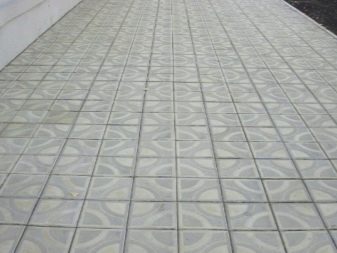
- 12 bricks, 8 bricks - contain a pattern consisting of two or three rectangles located horizontally and vertically.
- Brick - the name is fully consistent with the shape.
- Gzhelka is a double tile model with repetition of patterned rhombuses of different sizes. As a rule, they are combined with each other using contrasting colors.
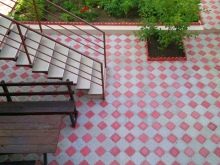
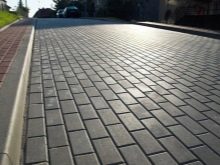
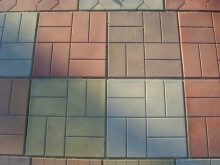
- Scales are original products that consist of small scales. There are many color variations of this tile.
- The grid is a square with an appropriate imitation. A distinctive feature is large cells.
- A cobweb is a large slab with a round pattern imitating a cobweb.
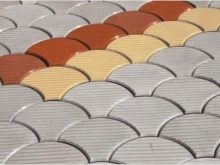
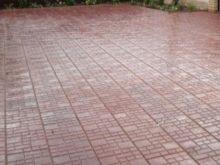
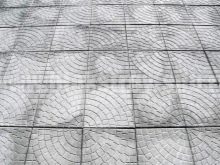
- A cloud is a square slab with a fancy pattern that looks like cracked ice or earth.
- Parquet is a square with imitation of several planks, somewhat reminiscent of toffee candy.
- Honeycomb is a hexagonal tile.
- Wave - the elements are shaped like a wave, a broken curve.
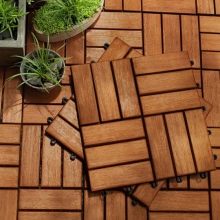
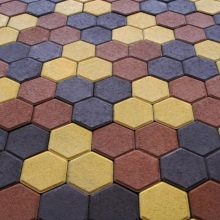
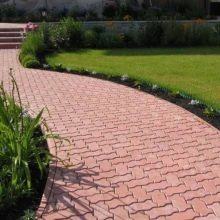
- Fleece - a tile looks like two scales connected to each other, the semicircular parts of which are directed in different directions.
- Clover - a carved rhombus; to understand its basis, it is worth taking a closer look at the "Embossed Clover" tile.
- Embossed clover - squares with corners cut into a circle and, accordingly, the circles themselves.

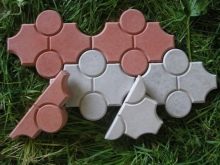
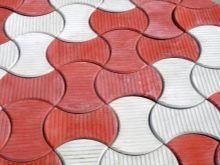
- Flower (chamomile) - a square, contains an ornament imitating a flower.
- Caso, Gothic and other similar options - they have an ornament that has been used since ancient times by the Greeks and Romans.
- Maple leaf - the name itself conveys the shape and design of the products, they are similar to maple leaves.


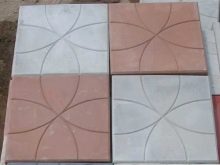
- Coil - in shape resembles a Tesla coil or from under the threads.
- The shell is a triangular rounded tile with edges cut off by an arc.
- L-shaped - resembles the Latin letter L.
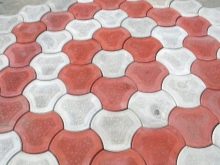
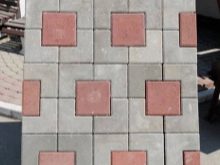
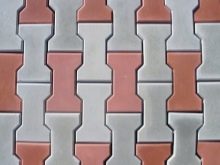
- Modern - rectangular tiles of various sizes and colors.
- Wood-like - "Hemp", "Planks", "Piece boards" perfectly imitate wood cuts, although they are tiles. They can be square, round, or rectangular.
- Curb, gutter - a special small tile fits its purpose.
And these are not all types of common paving slabs. The most popular ones are marked here.
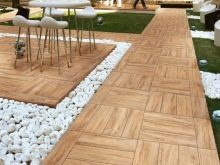


Dimensions (edit)
As you can see from the widest design variety, paving slabs are different. Each product has its own size, thickness, width and length. The thinnest paving slabs can be 20 mm thick, the thickest - 80 mm. Similar parameters for paving stones will be from 40 to 120 mm.
The choice of paving thickness depends entirely on the expected load on the surface.
If they only walk along the paths, then a tile with an average thickness of 3 cm will do, but if vehicles enter the pavement, then its height will be at least 5 cm, in some cases paving stones will be required.
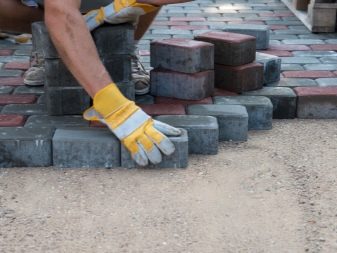
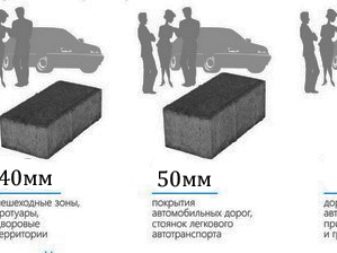
In addition to thickness, important parameters are the length and width of the products. Large tiles break easily and can be “adjusted” to the bends of the track. But it also cracks, due to its size, just as well. It should be noted that there are no standards for tile sizes. Each manufacturer has its own developed models with certain parameters.
Average sizes range from 200 to 500 mm in length, from 100 to 500 mm in width; sizes depend on shape and design. Moreover, some manufacturers can offer the same tile in several versions, from the smallest to the largest.
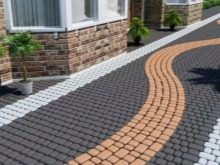
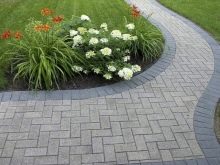
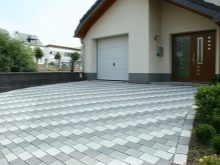
Colors
The color spectrum of paving slabs is very diverse. But when choosing products, you need to be especially careful about color.If there is too much dye in the concrete mixture, then such parts can be fragile and short-lived.
Natural colors prevail in the design of paving slabssimilar to the shades of stones - cobblestone, granite, basalt, marble and others. But if you wish, you can also find colored tiles - yellow, red, boiling white, green. Fortunately, today the paving market abounds in a wide variety of color schemes.
A favorite design technique is the use of several shades. Contrasting combinations, for example, black and white, look especially impressive.
And the black paving slabs themselves look very attractive.

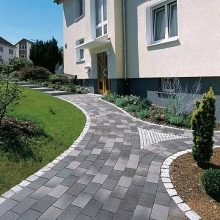
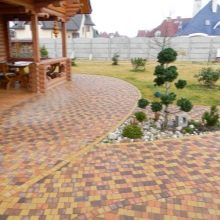
Materials (edit)
Design by design, but if the tile was originally of poor quality and from poor raw materials, then it will not last long and will please its owner only after laying. And it is possible that even during the installation process, a good "half" of the parts will be unsuitable for such work.
The most common paving products are made of concrete.
They may differ in manufacturing technology: be vibropressed or vibrated:
- Vibration casting - the form is filled with concrete solution, installed on a constantly vibrating base. Then the workpiece is removed, dried and painted.
- Vibration compaction - the concrete mixture is placed in a mold, which, in turn, is installed in special equipment, where the workpiece is subjected to vibration and pressure.
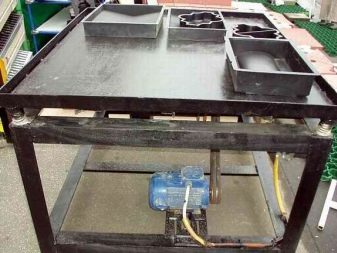
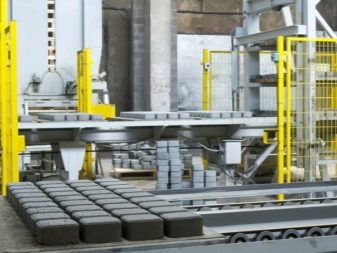
As a rule, tiles made by vibrocasting are ready already on the 2nd day. No powerful professional equipment is required for their manufacture. In appearance, such products are smooth, with a shiny surface, and can be of the most bizarre shape. In terms of its operational characteristics, a good high-quality vibrocast product is only slightly inferior to its vibropressed counterparts.
Vibro-pressed tiles are manufactured at the factory equipment within a few days. In appearance, the products are rough, with many options for colors and patterns. According to their characteristics, they are better than vibrocast products. In addition, there is an additional warranty from the manufacturers. As a rule, vibropressed plates are manufactured in factories.
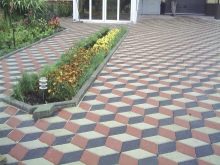
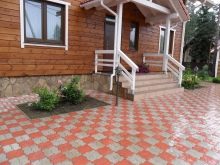

Among other things, concrete tiles can be additionally reinforced with a mesh of metal rods. Reinforced paving slabs contain metal elements. A distinctive feature of such products is its impressive dimensions (about 500 mm in length and width). Such concrete products can be of a wide variety of colors and designs, they are usually used for those areas where there will be little car traffic. For sites where freight transport will enter, it is recommended to use paving stones.
Natural stone paving slabs represent a cut of a stone or several stones. The main thing is that one side of the stone hemp is even. Such flagstones are made from granite, basalt or marble. Stone tiles are very durable and environmentally friendly. However, it has a rather high price, because of which many turn to the choice of a different coating.
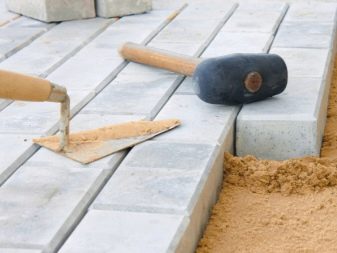
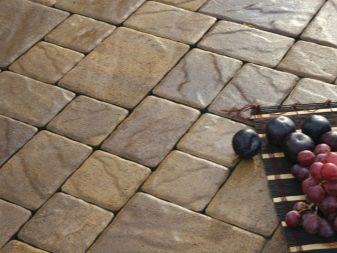
Paving slabs with crumb rubber or rubber are made from car tires. It is presented in a wide range of colors. Its main advantage is good shock-absorbing properties. Quite often, rubber tiles can be seen on playgrounds and sports grounds, stairs and paths where an anti-slip coating is needed.
Clinker paving slabs are made from special clay. It is fired at a very high temperature. It differs in natural shades. Possesses good anti-slip properties and fire resistance. However, the price of such products is not at all budgetary.
Polymer sand tile consists of sand and special polymers, which were baked in a special way.Also, tiles of this kind are also called plastic, because their parts, in fact, are made of plastic.
Plastic products have good durability, good looks and non-slip properties.
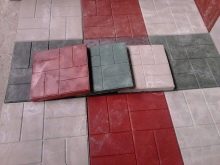
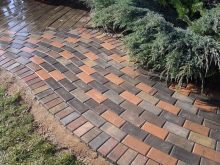

How to choose?
When choosing paving slabs for a summer residence, one should be guided by the following considerations:
- Estimated load on the paving site: for small footpaths, on which only occasional walks will be taken, narrow tiles are suitable. If a car drives into the road, then you should take a closer look at the most reinforced thick options.
- For what purposes is the path being built: perhaps there is a need for an anti-slip effect, for example, in front of the porch or when making an exit to the street. Then you need elements with a ribbed pattern, rough or rubber. The latter will be appropriate when building a playground for a children's or sports corner.
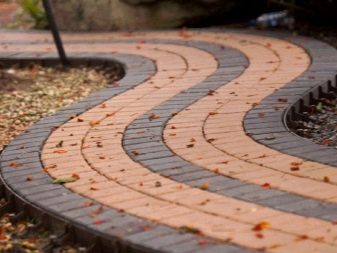
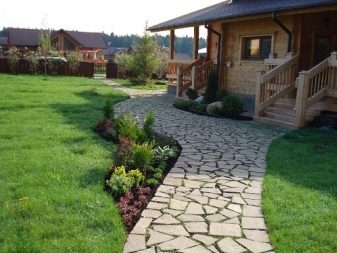
- Taste preferences. The design of the products is varied, for every taste and color. On the market today, you can choose calm, classic options of a square or rectangular shape, or complex curly elements with an unusual pattern. In addition, even the most ordinary tile can be advantageously beaten with an unusual laying - a herringbone, braid, chess, combining various colors, laying out a pattern.
- Financial opportunities - there are both expensive, exclusive options and more budgetary ones.
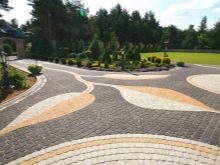

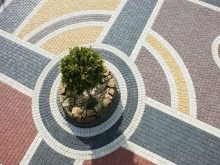
In order to determine a good concrete tile, the following test can be performed. Lightly bump the two pieces against each other. At the same time, a good high-quality tile should have a sonorous sound, otherwise low-quality mixtures were used in its manufacturing process. A good product should not have any defects, blotches, stains. The color must be uniform on both the top and bottom of the product.
Reputable manufacturers and sellers can provide certificates for their products.
When purchasing wholesale, special attention should be paid to products that were from the bottom of the pallets. It is on them that the greatest load goes.
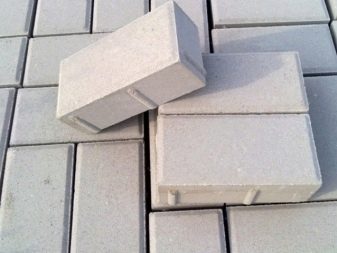
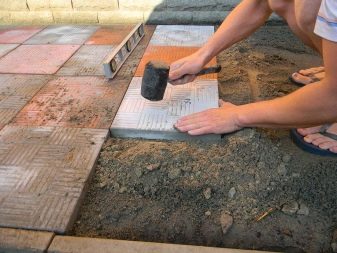
Manufacturers
The lineup, varieties and selection of paving slabs is simply huge today. The production of this kind of products can be carried out even independently at your dacha. What then can we say about giant factories? Vybor-S, Gothic, Stone Age, Braer produce several million square meters of tiles a year.
The production of clinker tiles stands apart. The production leaders here are Western companies, especially from Germany. Brands such as CRH, Mhur, Wienerberger, Feldhaus Klinker and others are firmly entrenched in the clinker tile market. True, domestic manufacturers such as, for example, Terex have found their niche in this segment.
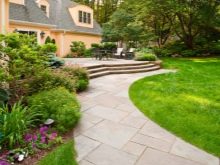


Beautiful landscape ideas
In small areas, designers recommend building ornate paths of flowing shapes. But large areas can be "lined" with clear straight lines.
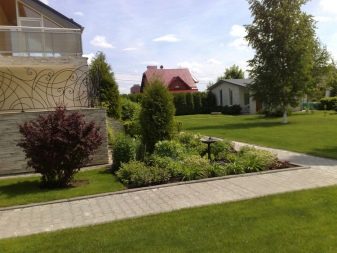
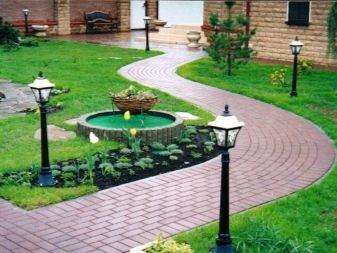
The main purpose of the paths in the garden is to connect different objects with each other, while the path must be inscribed in the landscape in the courtyard of a private house. In addition, the "object" itself on the site can be highlighted with the help of paving slabs. The covering can be around the house, gazebo, playground, flower beds.
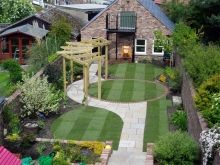
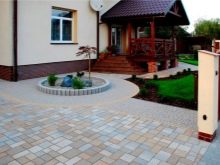

Country aesthetics dictate the choice in favor of environmental friendliness and naturalness. Young green grass breaking through concrete will always look fresh and relevant. Natural materials (stone, wood) and their imitations will also organically fit into the space of the cottage.
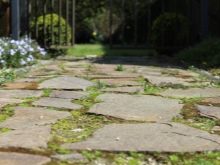
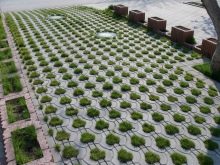
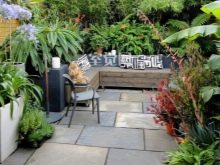
You will learn how to properly lay paving slabs in the following video.













The comment was sent successfully.